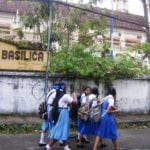The Colors of Southern India, Similar in Hue to Those of South America

The residences and businesses are painted with avocado and lime greens, pomegranate and mamey pinks, lilac lavenders, banana and star fruit yellows, papaya oranges and sand or garbanzo colored beiges. The security doors are a mix of roll down metal sheets painted in a rainbow of colors and bars, not unlike the rejas that cover most windows in Latin America. The walls that line the streets are covered with graffiti-like commercial and political messages, but the script is in Tamil or Malayalam, with their own curvaceous non-Roman lettering.
Kerala is a communist state. Even though we are legions away from Russia and Cuba, there are red images of the hammer and sickle, and men sport Che Guevara t-shirts. However, commercialism is everywhere. All the billboards here show gorgeous women with straight, jet black hair, olive complexion and huge dark eyes. While most the images look like the same model, one seems to resemble Salma Hayak. They all have the same smile, just draped in different colored saris. There are a few men in billboards, who all look somewhat like the TV host from Slumdog Millionaire.

Most buildings are concrete blocks. Some have thatched roofs. Others have tejas, or rolled down aluminum. Many have street side walls four-feet high, and some are topped with broken glass bits from beer bottles, to ward off any unwanted entry.

Bottles of carbonated drinks are hung decoratively around the kiosks like Christmas lights. They are pink, yellow soda, brown and light yellow. Beneath the sodas are large clear plastic canisters filled with candy. Sometimes there will be a street side grill with roti or chapatti which are similar to freshly made crispy flour tortillas on the comal.
Vehicles and people are maneuvering the streets in both directions, without sidewalks or traffic lanes, to the piti piti of the car, bus and bike horns. One of the biggest differences here from Latin America is that the drivers ride British style, on the left-hand side of the road. That also means you enter a bus from the left side, rather than the right.

Speaking of buses, the ones in India are packed just like those in Latin America. But as you make stops, there are no rambling vendors offering fruit, snacks or drinks. Nor do the passengers bring their own breakfast, lunch or dinner on board. The difference could be because Indians eat only two meals a day. Or, maybe because eating of meals in India is a bit more ceremonial. Another reason could be that Indians like to wash their hands before and after eating their forkless and spoonless meals, which like those of Latin America are heavy on the rice and seasoned with plenty of peppers and spices.
Some of the red or turquoise painted buses and most of the taxis in Southern India are open aired. The buses have the same Latin American system of a driver and a cashier. The money takers here are skinny men with a magician’s ability to pass through invisible spaces between hordes of people. In many areas here, it’s obligatory for the bus, taxi and rickshaw drivers to wear safari style khaki shirts. When they don’t, they are fined. This gives them a more professional look than the men behind the wheel or pocketing the bills in Latin America.
Here, too, the buses stop along the way to pick up passengers at no particularly marked bus stops. They may have a sign suggesting only 11 passengers stand in the aisle, but in reality, 11 are crowded in just between three rows of seats. People are encouraged to lean into the area where the lucky folks got a seat, to allow for more people to scrunch in together. Similar to the buses in Latin America, the space next to the driver is a prime spot for luggage or a friend of the driver. Unlike the courteous Latin men that will often give up their seat to a female, the Indian men rush to grab a seat as quick they can.
South India may be just as different from Northern India as is Quito from Guayaquil or Tierra del Fuego and Buenos Aires. Yet, worlds apart, there are so many likenesses, that bring a sense of home and welcoming to a very foreign land.





Once again thanks Deborah for sharing your experiences with us. Working with my Indian brothers I found many similarities in our culture.
Seeing an image of el “Che” and reading this post confirmed what I have been perceiving all these years.
Your article helped me a lot, is there any more related content? Thanks!
Модные советы по созданию стильных видов на любой день.
Статьи профессионалов, события, все коллекции и шоу.
https://watches.superpodium.com/
На данном ресурсе доступны оригинальные сумки популярного бренда Bottega Veneta. Здесь предлагается купить актуальные модели, которые станут изюминкой вашего гардероба. Каждое изделие отличается высочайшим качеством, что присуще бренду Bottega Veneta
https://mediajx.com/story20616090/bottega-veneta